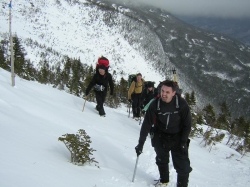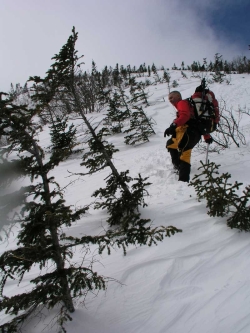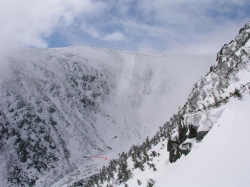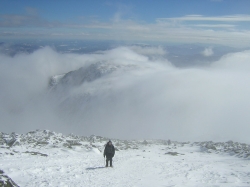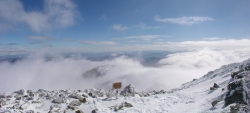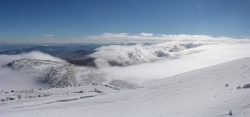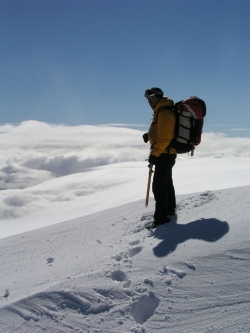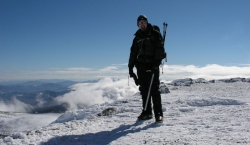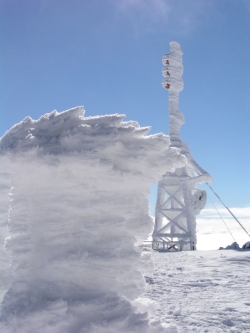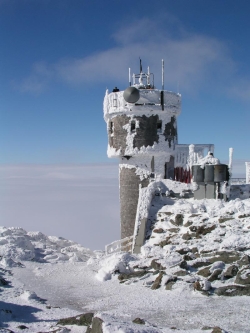|
Mount Washington Page 2
|
||
|
The plastic boots and crampons were significantly heavier than regular hiking boots and I was surprised at how fatiguing kicking steps into the snow was. I tried to step in Joe’s footprints as much as possible, but occasionally the snow would collapse and I’d end up to my waist in deep snow. Joe seemed to have a natural ability to sense the pace of the group and push us just to the point that we could manage. Soon the slope began to ease a bit and instead of a severe slope it became a moderate (but still strenuous) and continuous grade. The further we climbed the more the views improved: The trees started thinning as we climbed higher and soon our immediate destination was visible in and out of the clouds. Our goal was the Lion Head which is a distinct outcropping of rock overlooking Tuckerman’s Ravine on the slope leading up to the summit of Mt. Washington. When I asked Joe how much snow we were standing on he said it could be in places as much as 20 feet! The snow was so deep in some places that only the tops of the trees were visible. As we climbed higher and higher the clouds started breaking up and we were frequently being bathed in sunlight. The surrounding ridgelines remained shrouded in cloud throughout the day but over the immediate Mt. Washington summit area relatively clear skies prevailed. Joe leading us up toward Lion Head: The Lion Head outcropping: Off to the left side of the ridge leading to Lion Head is Tuckerman’s Ravine, a popular back-country ski area with a pretty terrifying headwall filled with snow. There was a person in the bottom of the bowl when we were hiking up the ridge (red arrow): Above Lion Head the slope gets steep again. This area is probably the area where self-arrest would likely be most useful. If you fell and slid on the snow you’d end up a long way down the mountain. This was also the section where Tim gave me some great advice on using the “rest step” to climb instead of my scramble and pant method. Instead of exerting a lot of energy taking six or seven quick steps then stopping to recover he said to just take small steps and rest for just a second locking the straight leg briefly to take the strain of the muscle. Using this technique I was much more comfortable and able to plod along at a much more steady pace with an overall increase in efficiency. During our climb the clouds continued to swirl around all of the surrounding ridgelines, only occasionally swooping down around us.
|
Much of this section above Lion Head was rocky and covered with hard ice and not much snow, probably due to the extreme winds that scour the slope: Me nearing the summit: I finally reach the wooden stairs that the summer visitors use. The wind blown rime ice covers everything on the summit hinting at just how bad conditions can get up there: A panorama shot at the top of the trail looking at Boott Spur poking out of the clouds: One of our awesome ironman guides, Joe, on the summit plateau: Boott Spur and the clouds funneling down into the valley: Our other super guide, Tim, stands on a drift on the summit: Happy to be on top! Rime ice coats a post on the summit: On the summit we all put on extra clothes since standing still the cold starts to creep in. We spent about a half hour up top eating, drinking and snapping photographs. A few of the summit observatory staff were outside enjoying the relatively mild conditions: Click here to continue to next page...
|
|

